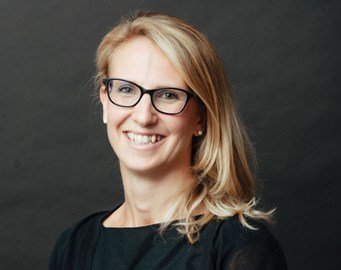Smell has long been regarded as the Cinderella of the senses, oft neglected by clinicians, the research community and lay public. The Global Consortium for Chemosensory Research looks to change all that. Our roving reporter, Abigail Walker, talks to its Chair, Prof Valentina Parma.

For many members of the general public, the catastrophe of anosmia resulting from COVID-19 infection is the first time that the importance of olfaction has entered their consciousness. For Professor Valentina Parma, however, olfaction has been her life’s work and academic passion, not only in the physiology of smell detection but in the integration of olfaction with our behaviour and social interactions.
Prof Parma’s career has taken her from Italy to Philadelphia, from where she leads the Global Consortium for Chemosensory Research (GCCR) as a worldwide collaboration to coordinate research into anosmia in COVID-19. Prof Parma was kind enough to take time out from her busy schedule of academia and clinical research to share a conversation with Abigail Walker.
What was the beginning of your passion for research into olfaction?
I joined chemosensory research as an undergraduate fascinated with perception and action. Serendipity brought me to olfaction among the other senses, as the lab in which I was doing my internship was newly focusing on the relationship between the sense of smell and the ability to plan actions. Delving into the olfactory literature tickled my curiosity and still does to this day.
Early in the pandemic, there was a lack of official recognition of the association between COVID-19 and anosmia, although there were many anecdotal reports of smell loss from patients suffering with anosmia after infection. What role do patients play in directing your research? Do you think it’s important to integrate them into planning research in smell, or should scientists set the direction?
Finding ways for patients and researchers to work together to improve quality of life and advance scientific knowledge is of paramount importance. A good example of a successful collaboration in this realm is the GCCR. The consortium, as well its leadership team, includes scientists and patient advocates who are in continuous communication. Patients offer their lived experiences, which inform research questions. Researchers synthesise the experiences of participants, contextualise them within the broader literature, and share the results back with the patient community. Albeit this format is new to many of those who are involved - we are eager to improve this collaborative effort and find more and more ways for patients and scientists to interact and co-produce research.
“We have devised three tools to study the chemical senses primarily in relation to COVID-19 and other respiratory illnesses”
It has been inspiring to see the strength of the international academic community unite against COVID-19 in collaborations such as GCCR. How did GCCR come to life – and how do you manage leading such a diverse group of scientists, researchers, and doctors?
I see GCCR as a sort of grassroot movement. Patients from all over the world shared on social media their smell and taste loss, and scientists – also from all over the world – responded. After emails and a growing mailing list in late March 2020, what would become the first GCCR leadership team got together on a Zoom call, and GCCR was created. Members kept joining, and still do to this day, and via townhall meetings and almost non-stop messages we have devised three tools to study the chemical senses primarily in relation to COVID-19 and other respiratory illnesses. Members’ enthusiasm and willingness to volunteer are the secret of this continued successful research and community building experience.
Have you found the recent surge in interest in olfaction with relation to COVID-19 to be a welcome spotlight on your work – or has it been a distraction to cope with the publicity?
One of my long-term goals has always been to produce evidence supporting the introduction of the sense of smell in clinical scenarios, as a diagnostic or treatment outcome. The COVID-19 pandemic unexpectedly acted as a magnifying glass on the message that smell is a tool for health. In that, I welcome the extensive attention that the chemical senses at large are receiving and the conversations between scientists, clinicians, patients advocates and the general public that are resulting from this attention.
Your research looks not only into the science of smell perception but its integration with other senses, and its role in modulating behaviour. Do you think that patients suffering with smell loss after COVID-19 will suffer related consequences - such as difficulty in social interactions or in detecting the subtle signals of danger or aggression?
This is one of the aspects I am most worried about: a large group of people that loses their senses of smell and taste and is left, often unprepared and unsupported, to live life without these senses. We know from the literature on pre-COVID-19 smell loss that losing one’s sense of smell has important repercussions on wellbeing, both at the social and nutritional level. We already see it being the case for people that are experiencing long-term COVID-19-related smell loss. I am working to provide information and ways to compensate the loss of this sense.
“The COVID-19 pandemic unexpectedly acted as a magnifying glass on the message that smell is a tool for health”
What piece of research are you most proud of?
I am extremely pleased with the research stemming from GCCR: it is addressing the timely and relevant problem of COVID-19 chemosensory changes, it does so on a global scale, and by using tools from the Open Science toolkit. It is a quintessential multidisciplinary effort that serves simultaneously to produce robust research outcomes and train new generations of chemosensory scientists. I am at works to expand the GCCR research agenda to non-COVID-19 areas and to produce chemosensory big data for the whole community to study.
With luck, we will be seeing all our international friends again in person soon as international travel restarts. Which conference are you most looking forward to attending in person - and is there a particular colleague that you are looking forward to seeing again?
I am truly hopeful for European Chemoreception Research Organization (ECRO) 2021 to be held in person. The organising committee and I are excited about celebrating together the 50th anniversary of the association as well as the 30th anniversary of the discovery of olfactory neurons and the 20th anniversary of the discovery of the taste receptor TAS1R. I am very much looking forward to meeting in person all the colleagues that I have worked closely with during these pandemic months virtually. Considering GCCR, the people that I am eager to meet are many!
And finally, one of my favourite pieces of research from your group is into the ability to discriminate terroir by olfaction. If one day we can all meet again and wave farewell to the pandemic – what wine can we bring for you that would most delight your olfactory neurons?!
You may be surprised, but my wine-appreciating skills are very limited: enjoying wine is an acquired pleasure that I have not yet developed. But if we convert the offer to a cocktail, I would choose a vodka sour with a touch of a salted caramel liquor. I hope we can enjoy our preferred beverages in person at ECRO 2021!







